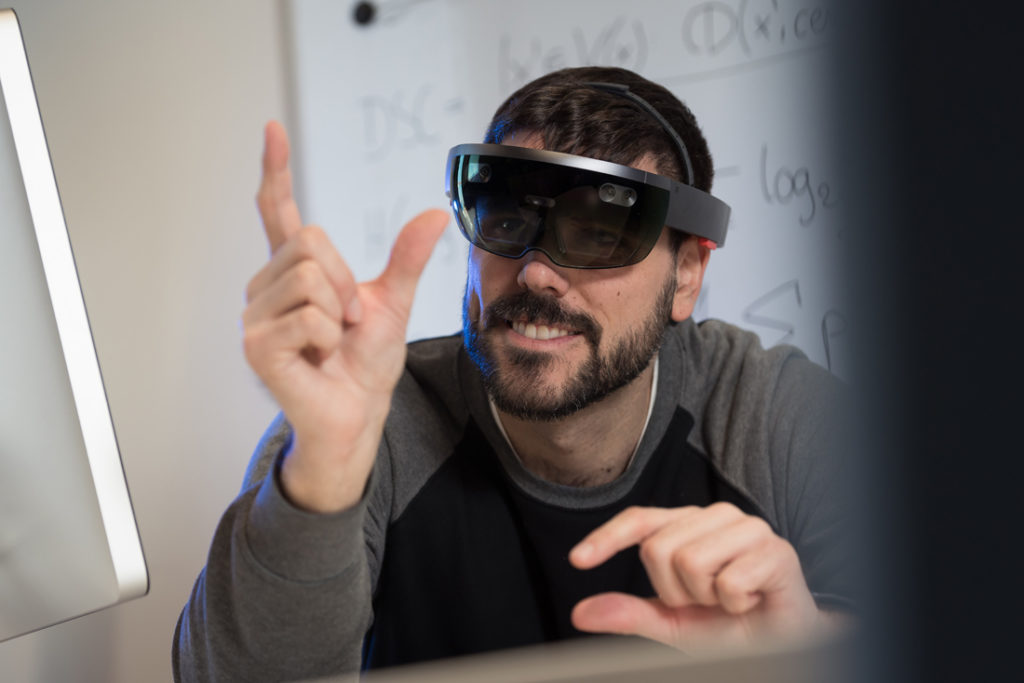Since August 2018, Michael Sedlmair is a researcher at the Visualization Research Center at the University of Stuttgart. As Assistant Professor his work focuses on the development of Augmented Reality (AR) and Virtual Reality (VR) solutions, Data Visualization, and Human-Computer Interaction (HCI).
In an interview he answered some questions regarding his current and future research activities and his idea of how our future might look like.

When did your interest in AR and VR technologies start?
My interest for AR/VR already started in the early 2000s during my undergrad program at the University of Munich. The topic of my Bachelor thesis, for instance, was using data gloves as novel input devices. Back then, I conducted my work with a P5 data glove, that tracked rubber strings that were attached to your fingers. While the technology was very limited the potential of using such AR/VR devices was fascinating to me as a clear illustration that Human-Computer Interaction has so much more to offer than mouse and keyboard (this was before iPhone). Ever since, the technology has emerged substantially. While we are still working with data gloves (and many other AR/VR input and output devices), these are now equipped with sophisticated force-feedback or even haptic feedback capabilities.
What are the questions you try to answer with your activities?
There are essentially two main research questions that I’m interested in when it comes to VR/AR:
- When is VR/AR really needed for analyzing & visualizing data?
- Does VR/AR offer us new and more natural ways to interact with data?
Over the last 10 years, I have been mainly working and publishing in the area of Data Visualization. With research question 1, my goal is to bridge these two areas. Doing that has always been a goal of both, the visualization and the VR/AR community (nowadays often referred to as immersive analytics). However, our studies have shown that it is not enough to make a visualization just 3D and put it into VR. This doesn’t make users more effective and in fact often perceptually “hurts” more than it helps. We thus need to be very careful when and for what to apply AR/VR technologies in visualization. Gaining a better understanding of this question is one of the core challenges of the success of this area in the future.
The 2nd research question adheres to my Human-Computer Interaction (HCI) interests. In fact, I usually refer to the broader area behind my research as “Human-Data Interaction”. This not only includes VR/AR, but also visualization, as well as aspects of Data Science and HCI. How users interact with data is one of the core challenges of the new information era. So far, the community that has focused most on interacting with data is again the data visualization community. However, current interaction paradigms in this area still mostly rely on mouse and keyboard. With my new group here in Stuttgart, we will look into completely novel and different ways of interacting with data, for instance, with force-feedback gloves, and evaluate them in comparison to existing approaches.
Where do you see the main usage fields for AR and VR solutions in our society?
Currently, this is the entertainment industry. However, there is much more beyond that. VR can, for instance, be used to help curing phobias. AR can be used for supporting surgeries or remote collaboration. In the long run, however, the biggest potential of these technologies lies – in my opinion – in telepresence. If we were able to provide tools to have AR/VR communication between humans on par with a face-to-face experience, then we would have a true disruptive technology. Sophisticated telepresence could help to tackle some of the huge societal challenges such as mobility and mega cities. Technically, we are still far away from this vision though.
What will you tell your students and PhD students that are interested in your research questions? What is most important when developing new solutions? What shall they keep in mind?
I am quoting my former colleague Monika Henzinger from the University of Vienna here: “Work on important problems and stay focused. There are simply too many interesting problems one can work on, and thus it is crucial to restrict one’s attention to the most important problems that one can contribute to.” This is a general advice, but I think it is immensely useful.

